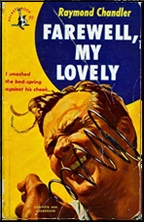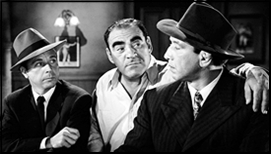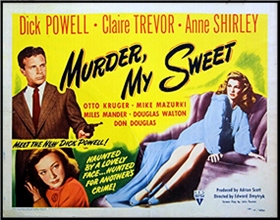Tue 10 Jan 2023
A Book! Movie!! Review by Dan Stumpf: RAYMOND CHANDLER – Farewell my Lovely // MURDER MY SWEET (1944).
Posted by Steve under Mystery movies , Reviews[9] Comments
RAYMOND CHANDLER – Farewell, My Lovely. Philip Marlowe #2, Alfred A. Knopf, hardcover, 1940. Reprinted many times.

MURDER, MY SWEET. RKO, 1944. Dick Powell, Claire Trevor, Anne Shirley, Otto Kruger, Mike Mazurki and Miles Mander. Screenplay by John Paxton, from the novel Farewell, My Lovely, by Raymond Chandler. Directed by Edward Dmytryk.
I like to get back to Raymond Chandler once a year or so, and late last year it was Farewell, My Lovely (1940) a fun read enlivened by Chandler’s polished prose and feel for violence. This is the one with Marlowe getting knocked around by Moose Malloy — a character who seems to have inspired the Incredible Hulk — then waking up in a sanitarium for more sadistic fun. Add some engagingly corrupt cops, stolen whoosis and the inevitable near-fatale femme and you get a book that set the standard for a whole generation of tough mysteries.

I have to say there’s about twenty-five wasted pages — something about Marlowe trying to get on a gambling ship that takes an awfully long time to reach a plot point he could have covered by a phone call, but by and mainly, Lovely still seems fresh and surprisingly un-clichéd nearly seventy years on.
This was filmed in 1942 as The Falcon Takes Over, with George Sanders’ debonair sleuth replacing Marlowe, and under its original title in 1975, with Chandler’s archetypal detective played by Robert Mitchum, himself something of an archetype by then. But the definitive version came out in 1944 under the title Murder, My Sweet.
Murder, My Sweet ushered in film noir, and no wonder; it’s a dazzling visual thing, brightly scripted and intelligently played, the kind of movie that sets a style and inspires imitation. Director Edward Dmytryk fills the screen with monster-movie imagery — hard shadows, cobwebs, lurking things coming out of the night — and plays it off beautifully against a hard-edged, take-no-sh*t attitude. Dick Powell’s Marlowe sometimes seems petulant when he ought to look tough, but for a trend-setting film, there are remarkably few false notes played here.

Speaking of notes though, the ending of Murder, My Sweet echoes another horror-influenced film released months earlier, The Pearl of Death (Universal, 1944) one of Roy William Neill’s superior “B†Sherlock Holmes series with Basil Rathbone. Both movies end with an unarmed detective cornered in a room with Miles Mander and a hulking brute enraged by… well, you get the idea.
I only wonder what actor Miles Mander must have thought, finding himself playing out the same scene at different studios just months, or maybe weeks, apart.

January 10th, 2023 at 4:49 pm
I like Powell as Marlowe. I like him even more as Richard Diamond in the radio series…
January 10th, 2023 at 4:54 pm
It always bugged me that Bogart is BOTH the film archetype of Marlowe AND Sam Spade. It makes no sense to me. I love Bogart–but I can’t say that subtlety was his strength. And for the life of me I can’t tell the difference between his portrayal of Spade and Marlowe–though the fictional counterparts are as different as steak tartare and filet mignon.
January 10th, 2023 at 5:25 pm
Miles Mander was an interesting man, more than just an accomplished upper-class actor.
He was an aeronautical pioneer, married an Indian princess and wrote a couple of interesting memoirs, some novels and directed, wrote and starred in a film based on one of them, The First Born, about a ruthless, philandering, radical politician Sir Hugo Boycott (based on Oswald Mosley, I suspect). Some of the complications turn on Boycott’s children, legitimate or not, and it’s made plain in a throwaway scene that in his African travels he’s had a child with an African woman, with no particular moral slant to the film’s attitude. It’s close to a masterpiece.
January 10th, 2023 at 6:27 pm
Here is the film First Born mentioned above:
https://rarefilmm.com/2019/02/the-first-born-1928/
January 10th, 2023 at 8:32 pm
This film remade Powell’s career and set an archetype he played for much of the rest of his career. He would play Marlowe one more time on television in an adaptation of THE LONG GOODBYE. Hopefully at least a kinescope of that and Richard Conte’s Sam Spade in “Too Many Have Lived” exists.
LOVELY is my favorite Chandler novel. I don’t think it is his best, but it the first one I read, and the most perfect balance of all the hardboiled elements. Even the Falcon film couldn’t hide how strong the storyline was and how well drawn the characters.
January 12th, 2023 at 1:37 pm
Tony, I would have agreed with your comment #2 years ago but now feel I can, as it were, detect a definite difference between Bogart’s cynical, borderline corrupt (e.g., his affair with Miles’s wife) Spade and his more jaded and romantic (very much facilitated by Bacall) Marlowe. Of course, I’m eternally grateful to him for inspiring me to read both Hammett and Chandler!
January 12th, 2023 at 2:22 pm
Matthew,
I can definitely detect the romantic chemistry between Bogie and Bacall in the Big Sleep that was missing in the Maltese Falcon between him and Mary Astor. But I guess I always attributed that to the real life romantic chemistry of the couple as well as how incredibly attractive Bacall was. Felt the same way about their chemistry in To Have and Have Not. In other words, I’m not sure he was acting. I think he really was in love with Bacall. And vice versa.
Thus I don’t know if I can credit Bogie for acting in love with Bacall and acting distanced from Mary Astor. I myself find myself falling in love with Bacall and distanced from Astor when watching the movies.
Not to mention that Sam Spade loved Brigid O’Shaughnessy more than Marlowe loved Vivian Rutledge. Spade was nearly willing to give up everything for O’Shaughnessy. By the end of the book, Spade is literally jaundiced and spent. He feels like he’s done. So it’s not surprising to the reader that he never appears in another novel. But it sure doesn’t seem that way just going by the films.
January 12th, 2023 at 7:33 pm
Tony,
Agreed, that even the great Huston film gives us a Sam Spade far removed from the tragic figure of Hammett’s novel. Because Hammett never lets us inside Spade’s mind save through dialogue and action it is easy to see him as the cool facile character played by Bogart, but read the book and that final devastating chapter when a spent and emotionally wasted Spade goes back to Archer’s widow losing what little respect Effie has for him, it is easy to see Hammett has destroyed him.
I’ve long thought Hammett was saying that being a good private detective destroyed Spade’s humanity, that in one way Brigid was his last desperate chance and in the end while upholding the law, solving the case, catching the murderer, and outwitting the bad guys he destroys what little is left of the human being Sam Spade.
I think FALCON is a much better novel than given credit for, not merely a great detective novel, as deep as anything from Graham Greene, and a classic Greek tragedy.
To support that I point out that “blonde Satan” line that describes Spade which I have long felt cues us to a Miltonic Fall, better to rule in Hell than serve in Brigid’s heaven…
January 12th, 2023 at 7:51 pm
David,
100%. I always thought the Maltese Falcon could’ve been titled ‘The Death of Love’.